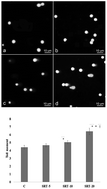Evidence for cardiotoxicity associated with sertraline in rats
Abstract
Sertraline is an antidepressant that is frequently prescribed to treat depression, obsessive–compulsive disorder, panic disorder, and anxiety. This drug had a safe cardiotoxicity profile, until the reporting of cases of sertraline-associated cardiotoxicities in the early 2000s. Since then, there have been conflicting results on the cardiotoxicity of this drug. In the study reported here we aimed to identify the cardiotoxic effects of sertraline by evaluating serum cardiac biomarkers, such as serum aspartate aminotransferase (AST), creatinine phosphokinase-myoglobin band (CK-MB), lactate dehydrogenase (LDH), and cardiac troponin T (cTn-T) levels as well as electrocardiographic parameters, DNA damage in cardiomyocytes, and histological findings of heart tissue in rats that were administered oral doses of 5, 10, or 20 mg kg−1 of sertraline for 28 days. Additionally, to investigate the possible mechanisms underlying cardiotoxicity, glutathione and malondialdehyde levels in cardiac tissue were determined to evaluate oxidative stress. According to our results, AST, LDH, and cTn-T levels were significantly increased in the 10 and 20 mg kg−1 sertraline groups when compared to the control group. Heart rates were increased, PR intervals prolonged, a short QTc value was observed, and T-wave amplitudes were decreased significantly in the 20 mg kg−1 sertraline group when compared to the control group. Significant DNA damage was observed in the high-dose groups. Histopathological investigations also revealed some degenerative changes in the 10 and 20 mg kg−1 sertraline groups. Glutathione levels were significantly decreased in the 10 and 20 mg kg−1 sertraline groups when compared with the control group. In conclusion, our findings support the cardiotoxic potential of sertraline and also suggest that oxidative stress may play a role in the toxicity of sertraline.



 Please wait while we load your content...
Please wait while we load your content...